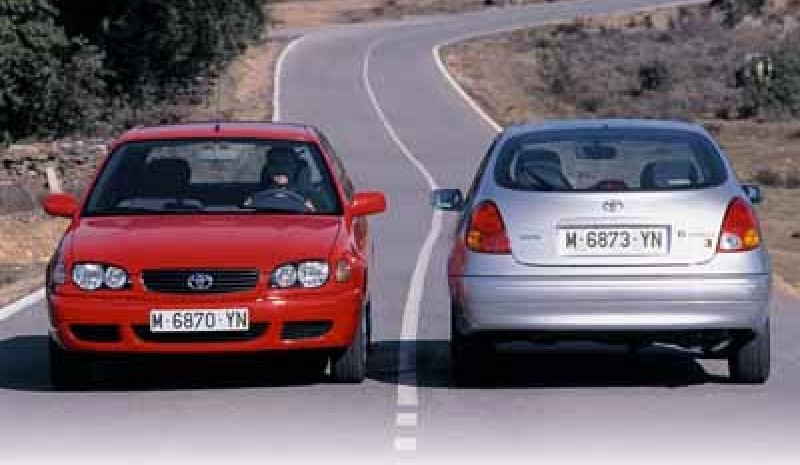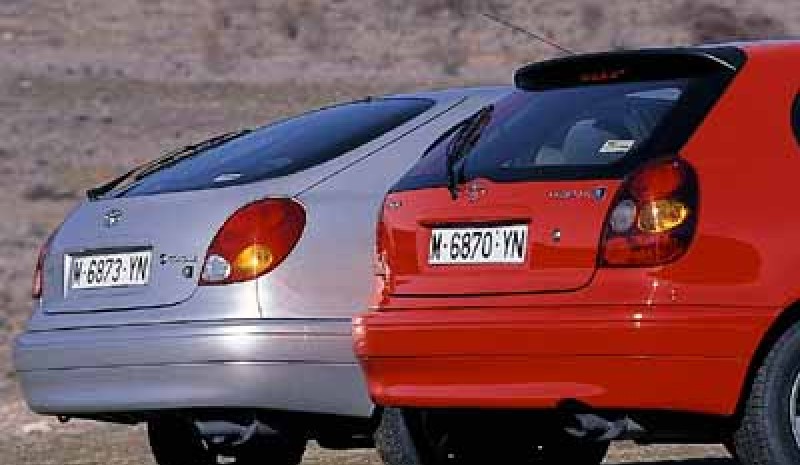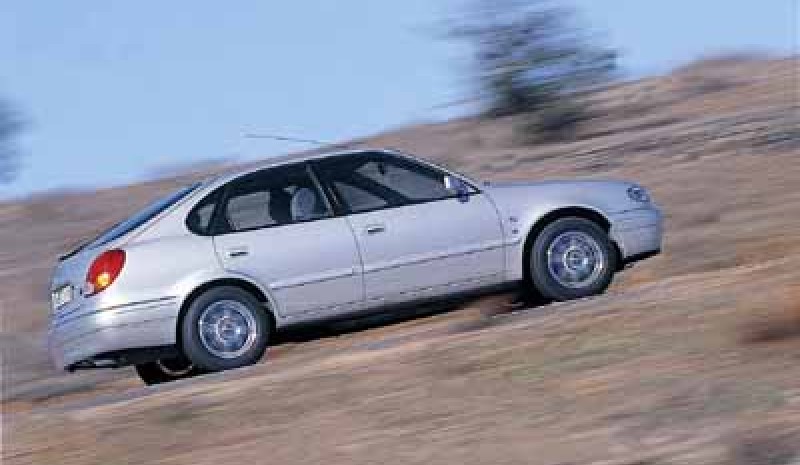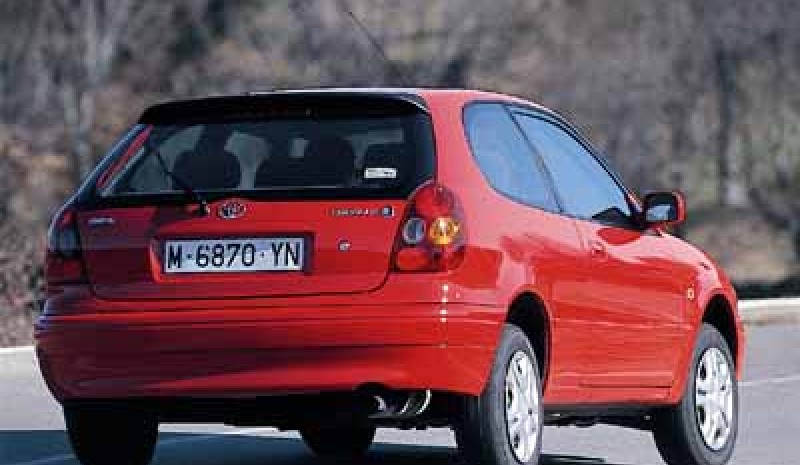Toyota Corolla Coupe 1.4 16V Terra / Toyota Corolla Sport 1.6 16V Sol Family
Toyota is committed to succeed in the segment’s sales monopolizes the compact. To this end, the Corolla has received many upgrades from interior and suspension to engine, now with variable valve timing
Aware of the success of the compact in European markets, the Japanese automaker Toyota wants to have their cake. For this, the Corolla, which had only three years after the sale, more adapted to Western tastes and requirements. For the potential buyer noticing that it is a nearly new product, changes externally, with new light clusters that give a more dynamic appearance. But where’s the differences is inside, especially with the use of darker materials that provide more solid feel appreciated. There is also a profound improvement in propellants, now the most modern among its competitors thanks to the variable valve timing.
What most wanted to check is whether Toyota has softened rear reactions in the Corolla. In the case of Family Sport is noticed more poise but, like the previous generation, it continues to move through abrupt reactions when third road apace. In tight corners, the rear wants to take a leading role, not to watch, you can put the driver in a hurry, especially when the throttle is lifted in support. Undoubtedly, the cantilever 17 centimeters more noticeable compared to Coupé, much milder reactions. These centimeters are in the back.
The greater weight of this axis on the hatchback (45 kg more than the coupe) and the same suspension as in the three doors make the behavior of either be completely different, more radical five doors against the nobility of Coupé. The smaller of the two highlights for a more refined frame. And we talked considering the best balance in terms of tire pressures, which in both cases was 2.2 bar (at most 2.3) on all four wheels. Neutral and progressive in all circumstances, not the rear tends to slide such a abruptly. Gradually we will find the measure to the car and the road making fun commuting, even the most winding roads. Yes, I would gain much in agility Coupe tires with higher side and lower drift than the Michelin Energy riding grip unit testing. In general, it is easier to drive, especially on secondary roads, when compared to the five-door vehicle.
Address in one and in another, is the best we can find thanks to a fast and accurate touch sensations transmitted to the driver. Whenever the asphalt is not very wavy contributes to an excellent guided vehicle. Should firm bumpy or in poor condition must hold the steering wheel decisively to keep the chosen direction, special efforts must be put into the most twisted road areas.
In the new generation Corolla found many good things, such as sixteen-valve engines. Both engines have a common denominator: the variable valve timing. When compared to the competition, equal displacement, they are the most powerful, with 110 hp 1.6 and 97 hp 1.4. Engines, on the other hand, very loyal bench as the power delivered is virtually the same as declared by the manufacturer. The two stand out for their ability to lap up. Unlike saving the horses in both smoothness and progression shines when delivered, especially in the small 1.4, which from low and medium engine displays all its arguments on questions of power. The 1.6 16V is more comfortable in the upper area where once passed the 3,000 revolutions is remarkable ease to reach the court on.
Soft throughout the speed range, the VVT-i, the same Celica Yaris and continuously controls the opening and closing of the intake valves, regardless of driving conditions and engine load. Thanks to the variable valve timing has advanced the time of peak torque in both engines. The end result is a more pleasant and with a very linear curve torque. Change is the typical Toyota, ie, precise and smooth with short journeys. The developments of the gearbox are well chosen and allow overtaking with ease. The sound is somewhat resentful when going very fast but not as much as the previous generation, with a marked improvement.
Aware of the success of the compact in European markets, the Japanese automaker Toyota wants to have their cake. For this, the Corolla, which had only three years after the sale, more adapted to Western tastes and requirements. For the potential buyer noticing that it is a nearly new product, changes externally, with new light clusters that give a more dynamic appearance. But where’s the differences is inside, especially with the use of darker materials that provide more solid feel appreciated. There is also a profound improvement in propellants, now the most modern among its competitors thanks to the variable valve timing.
What most wanted to check is whether Toyota has softened rear reactions in the Corolla. In the case of Family Sport is noticed more poise but, like the previous generation, it continues to move through abrupt reactions when third road apace. In tight corners, the rear wants to take a leading role, not to watch, you can put the driver in a hurry, especially when the throttle is lifted in support. Undoubtedly, the cantilever 17 centimeters more noticeable compared to Coupé, much milder reactions. These centimeters are in the back.
The greater weight of this axis on the hatchback (45 kg more than the coupe) and the same suspension as in the three doors make the behavior of either be completely different, more radical five doors against the nobility of Coupé. The smaller of the two highlights for a more refined frame. And we talked considering the best balance in terms of tire pressures, which in both cases was 2.2 bar (at most 2.3) on all four wheels. Neutral and progressive in all circumstances, not the rear tends to slide such a abruptly. Gradually we will find the measure to the car and the road making fun commuting, even the most winding roads. Yes, I would gain much in agility Coupe tires with higher side and lower drift than the Michelin Energy riding grip unit testing. In general, it is easier to drive, especially on secondary roads, when compared to the five-door vehicle.
Address in one and in another, is the best we can find thanks to a fast and accurate touch sensations transmitted to the driver. Whenever the asphalt is not very wavy contributes to an excellent guided vehicle. Should firm bumpy or in poor condition must hold the steering wheel decisively to keep the chosen direction, special efforts must be put into the most twisted road areas.
In the new generation Corolla found many good things, such as sixteen-valve engines. Both engines have a common denominator: the variable valve timing. When compared to the competition, equal displacement, they are the most powerful, with 110 hp 1.6 and 97 hp 1.4. Engines, on the other hand, very loyal bench as the power delivered is virtually the same as declared by the manufacturer. The two stand out for their ability to lap up. Unlike saving the horses in both smoothness and progression shines when delivered, especially in the small 1.4, which from low and medium engine displays all its arguments on questions of power. The 1.6 16V is more comfortable in the upper area where once passed the 3,000 revolutions is remarkable ease to reach the court on.
Soft throughout the speed range, the VVT-i, the same Celica Yaris and continuously controls the opening and closing of the intake valves, regardless of driving conditions and engine load. Thanks to the variable valve timing has advanced the time of peak torque in both engines. The end result is a more pleasant and with a very linear curve torque. Change is the typical Toyota, ie, precise and smooth with short journeys. The developments of the gearbox are well chosen and allow overtaking with ease. The sound is somewhat resentful when going very fast but not as much as the previous generation, with a marked improvement.




